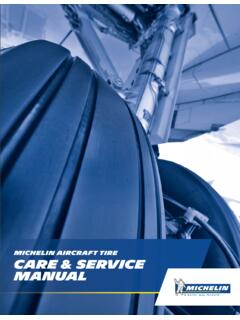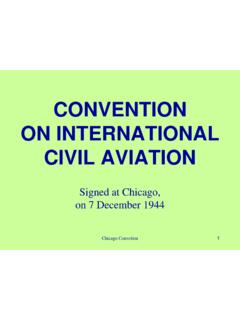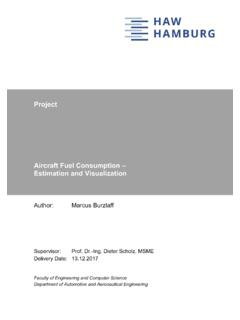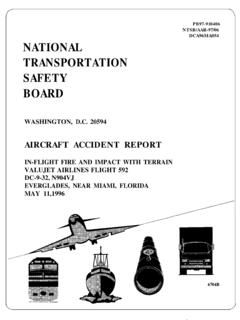Transcription of The Aircraft Maintenance Program and its importance on ...
1 1 The Aircraft Maintenance Program and its importance on Continuing Airworthiness Management Vitor Monteiro Correia Instituto Superior T cnico ABSTRACT In air transport, besides safety, the economical aspect of operation is the other base element for the success of the aviation industry. Therefore, the concern about economical and operational optimization has a prominent place on the literature. However, with this study it is intended to explore the Aircraft Maintenance Program as an element of Continuing Airworthiness Management (CAM). The objectives are: to present the methodology of AMP construction in accordance with the requirements of Continuing Airworthiness; to present the interrelation between the AMP and the other areas of Continuing Airworthiness; to demonstrate the importance of the AMP for the CAM.
2 As part of this study, it is developed and presents a complete AMP for fleet of Airbus A319 Aircraft . The demonstration of the importance of AMP for the CAM is done through the study of aviation accidents occurred between 1980 and 2011. After researching, the accidents on which the causes relate to the AMP where subjected to further study. This study demonstrated the importance of the AMP on the CAM, moreover the interrelation between the AMP and the other areas of CAM is fundamental for its effectiveness. Keywords: continuing airworthiness, Maintenance Program , Aircraft , EASA, air accident investigation 1. INTRODUCTION Empirically, the experience reveals that there is a general lack of understanding about the basis or Aircraft Maintenance Program (AMP), specially regarding the formalism required for its development.
3 This is due to the importance and focus given to the economical affairs in Aviation. In air transport, besides Safety, the economics of operations is the other base element for the success of the industry. In accordance with ICAO (International Civil Aviation Organization), Maintenance represents an average of 11% of operational costs of air operators up to 25%, depending on fleet size, age and level of utilization (Papakostas, Papachatzakis, Xanthakis, Mourtzis, & Chryssolouris, 2010). These studies focus primarily on operational optimizations within the concept of Maintenance management for aviation. However, with this dissertation, it is pretended to explore the AMP as basis for the Continuing Airworthiness, meaning the Maintenance of Aircraft safety without approaching the associated economics.
4 The following chapter begins by introducing the basic concepts of Continuing Airworthiness, and the standards and laws applicable in the European context. 2. CONTINUING AIRWORTHINESS Continuing Airworthiness is defined as all of the processes ensuring that, at any time in its life, an aeroplane complies with the technical conditions fixed to the issue of the Certificate of Airworthiness and is in a condition for safe operation (ICAO, Document n 9713/ (1998). The rule-making of Continuing Airworthiness is complex because it depends of requirements that change over time, technology developments and the diversity of Aircraft and manufacturers.)
5 The process of Continuing Airworthiness derives from the initial Aircraft Type-Certificate (certification given to a manufacturer to confirm that a certain Aircraft type abides the design safety or airworthiness requirements). The rules, standards and laws that regulate Continuing Airworthiness are established in two different organizational levels: ICAO International Civil Aviation Organization Definition of the responsibilities of member-state. Establishment of International standards for Civil Aviation. Aviation Authority Establishment of rule-making and procedures Control of Aviation related activities in general Three types of organizations regulated and controlled by Aviation Authority: Air Operators; Aircraft and Systems Design and Production Organizations; Maintenance Organization.
6 The ultimate responsibility for Continued Airworthiness is assigned in ICAO Annex 8 to the State of Design but the programme to achieve it is a matter for the State of Registry. In Europe, the Aviation Authority in title is EASA (European Aviation Safety Agency), which will be presented in the following paragraphs. 2 EASA European Aviation Safety Agency With the adoption of the Regulation (EC) No. 1592/2002 by the European Parliament and the Council of the European Union (EU) and the subsequent setup of the EASA, a new regulatory framework was created in European aviation. According to this Regulation for EU Member States, national regulations of airworthiness have been replaced by EU Regulation, and certification tasks have been transferred from National Authorities to EASA.
7 Non-EU States maintain their responsibility in all fields (De Florio, 2011). A Non-EU State may also adopt the rules and standards of EASA. EASA Responsibilities The main tasks of the Agency currently include (De Florio, 2011): Rulemaking: drafting aviation safety legislation and providing technical advice to the European Commission and to the Member States; Inspections, training, and standardization programs to ensure uniform implementation of European aviation safety legislation in all Member States; Safety and environmental type certification of Aircraft , engines, and parts; Approval of Aircraft design organizations worldwide and of production and Maintenance organizations outside the EU; Authorization of third-country (non-EU) operators.
8 Coordination of the European Community Program Safety Assessment of Foreign Aircraft regarding the safety of foreign Aircraft using Community airports; Data collection, analysis, and research to improve aviation safety. Main EASA standards There are three main standards of EASA related to Continuing Airworthiness: Part-21, Part-M, Part-145 that provide the requirements of Certification of Aircraft and components, Continuing Airworthiness Organizations and the Approval of Maintenance Organizations, respectively (EASA, 2012). EASA PART M EASA Part-M establishes the requirements and procedures necessary to Continuing Airworthiness Management. In accordance with AMC 201 of Part-M for commercial air transport, the operator is responsible for the continuing airworthiness of the Aircraft it operates and shall ensure that no flight takes place unless: The Aircraft is maintained in an airworthy condition, and; Any operational and emergency equipment fitted is correctly installed and serviceable or clearly identified as unserviceable, and; the airworthiness certificate remains valid, and; The Maintenance of the Aircraft is performed in accordance with the approved Maintenance programme.
9 EASA PART 145 Part-145 establishes the requirements and procedures necessary for the approval of Maintenance organizations of Aircraft . In accordance with Part-M, all Maintenance actions shall be undertake by and approved Maintenance organization. INAC Instituto Nacional de Avia o Civil Despite the fact the EASA regulates the safety of aviation in European Union, the responsibility of enforcing its rules is attributed to each Member-State, by designated state organizations. In Portugal, this organization is INAC. INAC an independent organization under the supervision of the Portuguese Government, and it is responsible for the certification and approval of activities, procedures, persons, Aircraft , infrastructures, equipments and systems related to civil aviation (INAC, 2012).
10 3. Aircraft Maintenance Program The Aircraft Maintenance Program (AMP) establishes the Maintenance tasks to be performed on a certain Aircraft , in order to maintain its airworthiness. The Maintenance tasks and their interval shall be such that they must enable the Maintenance of the Aircraft in the same operating and safety condition established by their design, throughout its life, either by the prevention of wear of materials and systems (preventive Maintenance ) or by the restoration of adequate operation and performance of Aircraft and its systems (corrective Maintenance ). The AMP is a corner stone of Continuing Airworthiness management; therefore it must be developed and evolved bearing in mind safety of Aircraft , as well as economical aspects.

















